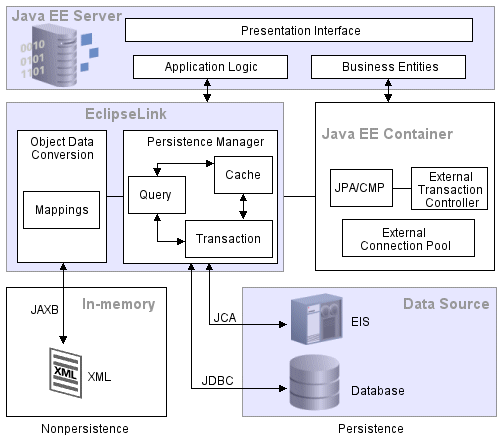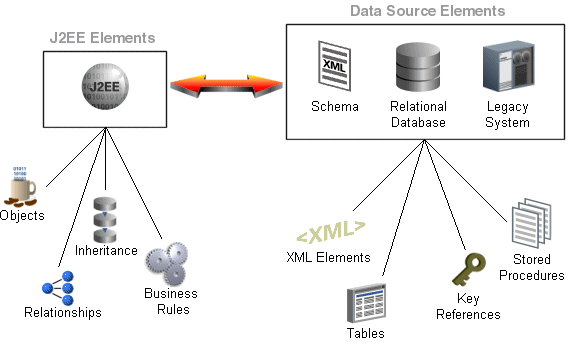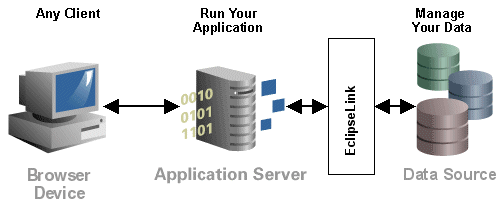Notice: This Wiki is now read only and edits are no longer possible. Please see: https://gitlab.eclipse.org/eclipsefdn/helpdesk/-/wikis/Wiki-shutdown-plan for the plan.
Introduction to EclipseLink (ELUG)
![]() For the latest EclipseLink documentation, please see http://www.eclipse.org/eclipselink/documentation/
For the latest EclipseLink documentation, please see http://www.eclipse.org/eclipselink/documentation/
Contents
What Is EclipseLink?
EclipseLink builds high-performance applications that store persistent object-oriented data in a relational database. It successfully transforms object-oriented data into either relational data or Extensible Markup Language (XML) elements.
EclipseLink Runtime Architecture
Using EclipseLink, you can integrate persistence and object-transformation into your application, while staying focused on your primary domain problem by taking advantage of an efficient, flexible, and field-proven solution (see What Is the Object-Persistence Impedance Mismatch).
EclipseLink is suitable for use with a wide range of Java 2 Enterprise Edition (Java EE) and Java application architectures (see EclipseLink Application Architectures). Use EclipseLink to design, implement, deploy, and optimize an advanced, object-persistence and object-transformation layer that supports a variety of data sources and formats, including the following:
- Relational–for transactional persistence of Java objects to a relational database accessed using Java Database Connectivity (JDBC) drivers.
- Object-Relational Data Type–for transactional persistence of Java objects to special purpose structured data source representations optimized for storage in object-relational data type databases such as Oracle Database.
- Enterprise information system (EIS)–for transactional persistence of Java objects to a nonrelational data source accessed using a Java EE Connector architecture (JCA) adapter, and any supported EIS record type, including indexed, mapped, or XML.
- XML–for nontransactional, nonpersistent (in-memory) conversion between Java objects and XML Schema Document (XSD)-based XML documents using Java Architecture for XML Binding (JAXB).
EclipseLink includes support for EJB 3.0 and the Java Persistence API (JPA) in Java EE and Java SE environments including integration with a variety of application severs including: Oracle WebLogic Server, OC4J, Glassfish/SunAS, JBoss, and IBM WebSphere application server. EclipseLink lets you quickly capture and define object-to-data source and object-to-data representation mappings in a flexible, efficient metadata format (see Working with EclipseLink Metadata).
The EclipseLink runtime lets your application exploit this mapping metadata with a simple session facade that provides in-depth support for data access, queries, transactions (both with and without an external transaction controller), and caching.
For more information, see EclipseLink Key Features.
What Is the Object-Persistence Impedance Mismatch
Java-to-data source integration is a widely underestimated problem when creating enterprise Java applications. This complex problem involves more than simply reading from and writing to a data source. The data source elements include tables, rows, columns, and primary and foreign keys. The Java and Java EE include entity classes (regular Java classes or Enterprise JavaBeans (EJB) entity beans), business rules, complex relationships, and inheritance. In a nonrelational data source, you must match your Java entities with EIS records or XML elements and schemas. These differences (as shown in the following figure) are known as the object-persistence impedance mismatch.
Solving Object-Persistence Impedance Mismatch
Successful solution requires bridging these different technologies, and solving the object-persistence impedance mismatch–a challenging and resource-intensive problem. To solve this problem, you must resolve the following issues between Java EE and data source elements:
- Fundamentally different technologies.
- Different skill sets.
- Different staff and ownership for each of the technologies.
- Different modeling and design principles.
As an application developer, you need a product that lets integrate Java applications with any data source, without compromising ideal application design or data integrity. In addition, as a Java developer, you need the ability to store (that is, persist) and retrieve business domain objects using a relational database or a nonrelational data source as a repository.
EclipseLink Solution
EclipseLink addresses the disparity between Java objects and data sources. EclipseLink is a persistence framework that manages relational, object-relational data type, EIS, and XML mappings in a seamless manner. This lets you rapidly build applications that combine the best aspects of object technology and the specific data source. EclipseLink lets you do the following:
- Persist Java objects to virtually any relational database supported by a JDBC-compliant driver.
- Persist Java objects to virtually any nonrelational data source supported by a Java EE Connector architecture (JCA) adapter using indexed, mapped, or XML enterprise information system (EIS) records.
- Perform in-memory conversions between Java objects and XML Schema (XSD) based XML documents using JAXB.
- Map any object model to any relational or nonrelational schema, using the Workbench graphical mapping tool or Oracle JDeveloper EclipseLink editor.
- Use EclipseLink successfully, even if you are unfamiliar with SQL or JDBC, because EclipseLink offers a clear, object-oriented view of data sources.
EclipseLink Key Features
EclipseLink provides an extensive and thorough set of features. You can use these features to rapidly build high-performance enterprise applications that are both scalable and maintainable.
Some of the primary features of EclipseLink are the following:
- Nonintrusive, flexible, metadata-based architecture (see Working with EclipseLink Metadata)
- Architectural flexibility: Java Persistence API (JPA), Plain Old Java Objects (POJO), Java API for XML Binding (JAXB), and Web services.
- Advanced mapping support and flexibility: relational, object-relational data type, Enterprise Information Systems (EIS), and XML.
- Optimized for highly scalable performance and concurrency with extensive performance tuning options.
- Comprehensive object caching support including cluster integration.
- Extensive query capability including: EclipseLink Expressions framework, Java Persistence Query Language (JP QL), and native SQL.
- Just-in-time reading
- Object-level transaction support and integration with popular application servers and databases.
- Optimistic and pessimistic locking options and locking policies.
- Comprehensive visual design tools.
For additional information, see the EclipseLink page: http://www.eclipse.org/eclipselink/.
EclipseLink Application Architectures
You can use EclipseLink in a variety of application architectures, including three- and two-tier architectures, with or without Java EE, to access a variety of data types on both relational and nonrelational data sources.
EclipseLink and Your Application Architecture
For more information on strategies for incorporating EclipseLink into your application architecture, see Designing Your Application with EclipseLink.
This section introduces some of the following common enterprise architectures used by EclipseLink applications:
- Three-Tier -- The three-tier (or Java EE Web) application is one of the most common EclipseLink architectures. This architecture is characterized by a server-hosted environment in which the business logic, persistent entities, and the EclipseLink Foundation Library all exist in a single Java Virtual Machine (JVM). See Considering Three-Tier Architecture for more information.
The most common example of this architecture is a simple three-tier application in which the client browser accesses the application through servlets, JavaServer Pages (JSP) and HTML.
The presentation layer communicates with EclipseLink through other Java classes in the same JVM, to provide the necessary persistence logic. This architecture supports multiple servers in a clustered environment, but there is no separation across JVMs from the presentation layer and the code that invokes the persistence logic against the persistent entities using EclipseLink. - EJB Session Bean Facade-- A popular variation on the three-tier application involves wrapping the business logic, including the EclipseLink access, in EJB session beans. This architecture provides a scalable deployment and includes integration with transaction services from the host application server. See Considering EJB Session Bean Facade Architecture for more information.
Communication from the presentation layer occurs through calls to the EJB session beans. This architecture separates the application into different tiers for the deployment. The session bean architecture can persist either Java objects or EJB entity beans. - EJB 3.0 Entities with JPA -- The EJB 3.0 specification includes an additional persistence specification called the Java Persistence API (JPA). You can use this API for creating, reading, updating, and deleting plain old Java objects (POJO) within both a compliant EJB 3.0 Java EE container and a standard Java SE 5 (or later) environment.
EclipseLink JPA is a standards compliant JPA persistence provider built on the EclipseLink foundation library. EclipseLink JPA offers a variety of vendor extensions (annotations and persistence properties) that give you full access to the underlying EclipseLink API.
For more information, see:
- Web Services -- A Web services architecture is similar to the three-tier or session-bean architecture. However, in a Web services architecture you encapsulate business logic (the service) in a Web service instead of (or in addition to) using session beans. In a Web services architecture, clients communicate with your application using XML.
As in any architecture, you can use EclipseLink to persist objects to relational or EIS data sources. However, in a Web services architecture you can also use EclipseLink to map your object model to an XML schema for use with the Web service or as the Web service XML serializer.
See Considering Web Services Architecture for more information - EclipseLink Database Web Services -- EclipseLink database Web services architecture (introduced in 1.1) is similar to the Web services architecture. However, in an EclipseLink database Web services architecture, you use EclipseLink to automatically generate Web services that expose database operations such as queries, DML statements, and stored procedures and stored functions. Using EclipseLink database Web services, you can provide Java EE compliant, client-neutral access to a relational database without having to write Java code.
As in any Web services architecture, clients communicate with your application using SOAP (XML) messages. However, in an EclipseLink database Web services architecture you need only specify an XSD for persistent classes. Clients need only invoke the operations the EclipseLink database Web service exposes to create, read, update, and delete these persistent objects. EclipseLink database Web services return objects or row set data, depending on the type of operation. See Considering EclipseLink Database Web Service Architecture for more information. - Two-Tier -- A two-tier (or client/server) application is one in which the EclipseLink application accesses the database directly. Although less common than the other architectures discussed here, EclipseLink supports this architecture for smaller or embedded data processing applications.
See Considering Two-Tier Architecture for more information.



